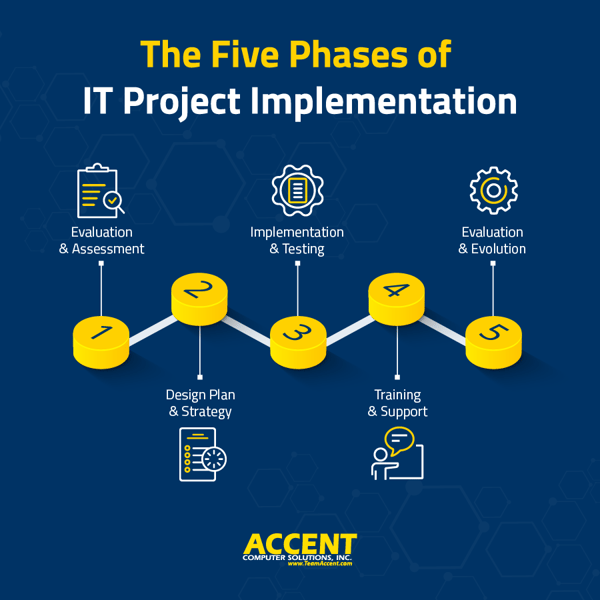If you had a bad experience with your last IT project, it’s understandable if you’re reluctant to give the go-ahead on the next initiative that needs your approval. Unfortunately, with the pace that technology changes, you can’t just get your IT systems to a certain point, say “done.”
Technology is always evolving. Further IT projects are inevitable.
Continuous improvement and investment are required if you want to use technology to move your organization forward. If you don’t invest, outdated technology will ultimately hold you back.
Is it possible to have a good IT project experience? Absolutely!
Let’s examine what may have happened to produce lackluster results with your previous IT projects. Then we’ll go through the steps you need to take to set up your next project for success.
What IT Project Disappointment Looks Like
Sometimes IT projects disappoint because they’re not strategic. That is, they don’t align with the organization’s goals. Other disappointments happen because the project wasn’t thoroughly planned. And in some cases, projects are considered disappointments because expectations weren’t realistic.
Any of these sound familiar when you think about an IT project gone wrong?
- Business operations were disrupted
- Didn’t get the anticipated business results
- Inconveniences slowed down processes
- Productivity slumped
- Employees were frustrated
- Costs went over budget
It doesn’t have to be that way.
Here are 3 steps we see that help IT projects run smoothly and meet expectations.
- Set Realistic Expectations for IT Projects
- Have a Point of Contact as the Conduit for Communication
- Plan Out Your Process for Seamless IT Project Implementation
1. Set Realistic Expectations for IT Projects
Let’s address the first expectation on the list above and say it straight out – IT projects can be disruptive.
Even though they’re disruptive, you can still have a good experience. The way to have a good experience is to set realistic expectations.
Address Real Business Needs
Before you do anything else, determine if the project makes sense for your business.
Sometimes people want new technology because it’s cool and new, or they heard someone talk about it. Before making any decisions, evaluate all aspects of the project to determine if it meets business objectives.
Allow for a Thorough Planning Process
There’s no way to avoid disruptions from IT projects. But those disruptions can be minimized when every detail of the process is documented, and every nuance addressed. In addition, having a solid understanding of what could cause disruption will leave you better prepared and allow you to put a temporary contingency plan in place.
Allocate Plenty of Time
Along with thorough planning comes allocating enough time for the project to be tested and rolled out.
Realistic expectations for how long an IT project will take are important. Not just to know the duration but also to see if you’ll be able to meet deadlines.
Communicate Your Expectations
Communication is an essential ingredient for any successful IT project.
Communication is a significant aspect of the previous points, but it’s important enough to call out on its own. Excellent communication will help you avoid many of the frustrations that might occur, as it’s the method for setting expectations with your people.
2. Have a Point of Contact as the Conduit for Communication
In order to be successful, it’s essential to have someone at your company act as the point of contact for the project.
This person is in continual contact with the IT company managing your project and acts as the conduit of information to and from your business.
Your point of contact will also need to be 100% invested in ensuring that the project gets the attention that’s required. They’ll need to facilitate decision-making. For example, if there’s a decision that needs to be made during the course of the project, they’ll be the one to talk to the right person (or people) at your company to get that decision in a timely manner.
They’ll also need to facilitate collaboration with other people at your company and the IT support company doing the project. An example of this would be getting the appropriate people to test out the new technology being implemented.
Along the way, the point of contact may need to communicate changes that need to be made or omissions that have been discovered.
In summary, the point of contact acts as communicator and your internal project coordinator. They’ll need to make sure that they dedicate the necessary time and attention to keep the project moving to completion for the portions that require input.
3. Plan Out Your Process for Seamless IT Project Implementation
The vendor’s solid process for planning and implementing IT projects is key.
At VC3, we have a five-phase project process:

1. Evaluation & Assessment
This part of the process happens in what we call the IT Results Cycle.
Our IT Results Cycle identifies technology issues or objectives that will meet business needs, such as increasing security, improving productivity, or reducing costs. Then, we evaluate solutions and make recommendations that can be added to the client’s unique technology plan, while remaining mindful of the company's growth and evolving needs.
2. Design Plan & Strategy
Once a solution is selected, we evaluate how that solution will impact the business and if the outcome will enhance the competitive advantage as desired. Then we develop the detailed project plan and set the schedule.
3. Implementation & Testing
This is the fun part.
We aim to roll out the new technology or make a cutover with as little impact on business operations as possible. One way we can do that is by selecting a group of test users to thoroughly probe the system and identify anything that does not work as anticipated.
A systematic detailed and systematic approach to system cutovers helps keep the impact to operations minimal and solves many issues BEFORE the rollout is completed.
4. Training & Support
When a new technology is rolled out, issues and training opportunities are bound to come up. We're routinely onsite following every major technology implementation to make sure clients have training & support for any potential issues that may come up.
Depending on the type of project, product and solution champions may be identified early in the process. They work closely with us to make sure they have adequate training before the completed rollout. These team members will be critical in ensuring that the solution’s adoption is positive.
5. Evaluation & Evolution
Technology never stops evolving. There will always be updates, modifications, and obstacles that need support, and we'll be there to help plan for different business situations and address ongoing challenges every step of the way.
🔎 Related: What Does the Professional IT Services Department Do?
IT Projects and Managed Services for Southern California Businesses
If you’ve had bad experiences with IT projects in the past, you might not just need a different process. You may need a different company – one that already has a track record with successful IT project planning and implementation.
At VC3, we provide Southern California companies with the managed and professional services needed to use technology as a competitive advantage.
Contact us to schedule a free IT assessment. We’re eager to learn about your goals and challenges and we're happy to provide a fresh perspective on what’s going on with IT and how to improve it.


